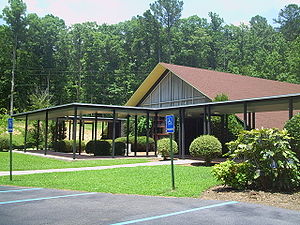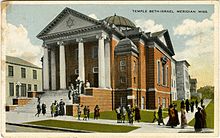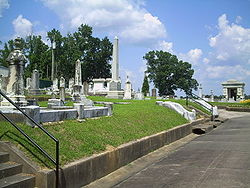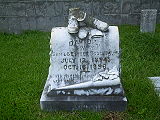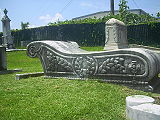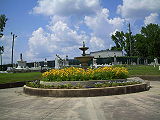- Congregation Beth Israel (Meridian, Mississippi)
-
Congregation Beth Israel Temple Beth Israel in 2010, viewed from southwest
Basic information Location Meridian, Mississippi, USA Geographic coordinates 32°25′14″N 88°41′31″W / 32.420466°N 88.692048°WCoordinates: 32°25′14″N 88°41′31″W / 32.420466°N 88.692048°W Affiliation Reform Judaism Status Partially active Leadership Rabbi David Goldstein (part-time) Website http://cbimeridian.org/ Congregation Beth Israel in Meridian, Mississippi is a Reform Jewish congregation founded in 1868 and a member of the Union for Reform Judaism. The congregation's first permanent house of worship was a Middle Eastern style building constructed in 1879. The congregation moved to another building built in the Greek Revival style in 1906, and in 1964 moved to a more modern building, out of which they still operate.
The congregation was initially made up of only ten families but grew to include 50 members by 1878. By the time their second building was built in 1906, the congregation included 82 members, and Meridian as a whole had grown to include 525 Jewish residents by 1927. By the 2000s there were fewer than forty, mostly elderly Jews remaining in the city, however, and the congregation no longer has a full-time rabbi. Former rabbis include Judah Wechsler, after whom the Wechsler school was named, and William Ackerman, whose wife Paula Ackerman became the first woman to perform rabbinical duties in the country after her husband's unexpected death.
In 1968, the education building of the new complex was bombed by members of the Ku Klux Klan. Pieces of glass were salvaged from the destruction and are now incorporated into the front windows of the current synagogue building. The congregation owns and maintains a historic cemetery at 19th Street and 15th Avenue which was listed on the National Register of Historic Places in 1989.
Contents
History
In the early days of Lauderdale County before Meridian was established, the nearby town of Marion was the largest settlement in the area.[1] The families of Abraham Threefoot, Isaac Rosenbaum, Leopold Rosenbaum, E. Lowenstein, and Jacob Cohen lived in Marion during these early years.[2] These families, along with other Jews in Marion, worked with Jews from the up-and-coming Meridian to build a temple halfway between the two towns. After the American Civil War, Meridian began to grow rapidly and Marion began to decline. As a result, many of Marion's Jews elected to move to Meridian. In 1868, the Jewish community established the first Jewish congregation in Lauderdale County, Beth Israel, and bought the lot which is now the Beth Israel Cemetery for $100 (today $2,000).[1]
The congregation initially consisted of only ten families and met in several temporary locations before moving to a permanent building. These locations included a house on 24th Avenue and 9th Street, a room above Carney's Grocery Store, and Sheehan Hall. In this interim period, the congregation grew to include 50 members by 1878, with David Burgheim serving as rabbi. The Middle Eastern style building on 22nd Avenue, constructed by the growing congregation in 1879, was the first building in the city with gas-powered lighting.[1] Rabbi Burgheim was succeeded by Rabbi W. Weinstein, then Rabbi Jacobs, and then Rabbi Judah Wechsler.[1] Wechsler, who became rabbi in 1887, led a movement to provide public schools for blacks, which culminated in a bond issue to construct the first brick public school building for African Americans in the state. The Wechsler School was named after him[2] and has since been listed on the National Register of Historic Places[3] and as a Mississippi Landmark.[4]
In 1906, a new Greek Revival octagonal synagogue designed by architect P.J. Krouse and modelled after the Temple of Athena Nike was built at the corner of 11th Street and 24th Avenue. The marble steps leading to the entrance of the building were flanked by large Ionic columns. The new synagogue could seat 500 and featured stained glass windows displaying the Ten Commandments, a menorah, the Star of David, and Noah's Ark. A fire damaged the building during its first year of operation, and while it was being repaired, services were held at St. Paul's Episcopal Church. By 1907, the congregation had grown to include 82 members and was led by Rabbi Max Raisin. By 1927, the Jewish community in Meridian had grown to 525 people, partly due to an influx of immigrants from Eastern Europe. The members of Beth Israel sponsored these newcomers, helping them to find jobs and homes and holding night classes to teach them English.[1]
Some of the congregation's members had preferred a more strict form of worship and a smaller Orthodox congregation, Ohel Jacob, had been formed in 1895. The two congregations had good relations, however, and a number of Meridian Jews belonged to both.[1][5]
In 1951, the congregation included 100 members and was the second largest Jewish community in the state.[6] When Rabbi William Ackerman, who had served the congregation from 1924 to 1950,[1] suddenly died while still in service, Beth Israel asked his wife Paula Ackerman to take his place until they could find a replacement.[2] No women had been ordained at this time, and it would be a full 20 more years before the first woman would be officially ordained in the United States. Nonetheless, without ordination Paula Ackerman served as "spiritual leader" (the congregation elected not to call her "rabbi") for three years until Beth Israel could find another. Despite the unwillingness to call Ackerman "rabbi," she performed all the duties of a normal rabbi, including conducting weekly Shabbat services, giving sermons, and performing marriages and funerals. In spite of much media attention and criticism from other Jews in the country, the congregation remained united under her leadership.[1] (Ackerman would later move to her original home of Pensacola, Florida, where she would serve as an interim rabbi at Temple Beth-El for nine months in 1962 until a replacement was found.[7])
By 1964, the temple was in need of repairs, and some older members found it difficult to get up the steep marble steps at the entrance.[8] Instead of repairing their 60 year old building in downtown, they purchased a 5-acre (2.0 ha) plot in the Broadmoor residential subdivision of Meridian and built a new synagogue.[1] The new facility, located at 57th Court and 14th Avenue,[9] was dedicated in December 1964 and was composed of a 200-seat sanctuary, a social hall with a kitchen and a library, and an education building.[1]
1968 Ku Klux Klan bombing
During the American Civil Rights Movement in the 1960s, the leadership of Beth Israel spoke out against the Ku Klux Klan's attacks on black churches. In response, Thomas Tarrants of Mobile, Alabama, who had helped bomb the synagogue building of Beth Israel Congregation and its rabbi's house there[2][10] bombed Beth Israel's education building on May 28, 1968.[1][11] The blast was caused by about 15 sticks of dynamite planted by Tarrants and his accomplice, Danny Joe Hawkins,[10][12] a top hitman in the White Knights of the Ku Klux Klan.[13] The force of the blast knocked down several walls of the education building and caved in part of the roof while also destroying a door at the opposite end of the synagogue building.[11] A hole approximately 24 inches (61 cm) in diameter was left in the concrete floor, and damages were estimated to be around $50,000 (equivalent to $316,000 today).[12] A reward of $10,000 was offered by the Meridian City Council, and $15,000 extra was promised by the Jewish community of the city.[12] According to Sammy Feltenstein, past president of Congregation Beth Israel, pieces of stained glass that survived the bombing were salvaged and adorn the front window of the synagogue today.[14]
On June 30, Tarrants[15] returned to Meridian to bomb the home of Meyer Davidson, an outspoken leader of the Jewish community, on 29th Avenue.[1][14] The FBI and police chief Roy Gunn convinced Raymond and Alton Wayne Roberts, local Klan members, to gather information about the Klan's operations. Alton was free on bond after being convicted in connection with the Mississippi civil rights workers murders in 1964.[10] Leaders of the Jewish communities in Jackson and in Meridian had raised money to pay the two informants, who tipped off the FBI about the attack before it happened.[2] Fifteen police officers were hidden around Davidson's house shortly after midnight when a car stopped about 50 feet (15 m) away from the house. Tarrants exited the vehicle with a box, later found to include 29 sticks of dynamite, and approached Davidson's carport. When police ordered him to stop, he dropped the box and fled to his vehicle. Officers then chased him for about 15 blocks before ramming the back of his vehicle, ending the chase. Tarrants opened fire on the policemen with a German-made 9mm submachine gun, striking officer J.M. Hatcher four times in the chest (though critically injured, the officer survived). Tarrants fled through the neighborhood continuing to fire at the policemen. Robert Burton, a resident of the neighborhood, opened his door to see what was going on and was struck by stray bullets. Police eventually found Tarrants in a pool of his own blood in a local resident's backyard. Kathy Ainsworth, a 26-year-old fifth grade school teacher from Jackson who had helped with the bombing of Jackson's synagogue a few months earlier,[10] was found dead in the car with a loaded pistol in her purse.[15] The car's owner was identified to be Danny Joe Hawkins, who had helped bomb Beth Israel; he was arrested on robbery charges a few weeks later.[13] Tarrants survived his wounds and was sentenced to a thirty year term in Parchman prison. He was paroled eight years into his term to enter the University of Mississippi after a religious conversion, and in 1992 he was training missionaries in North Carolina.[10]
Cemetery
Beth Israel CemeteryBeth Israel Cemetery in 2010Location: 19th Street and 5th Avenue, Meridian, Mississippi Coordinates: 32°22′38″N 88°40′57″W / 32.37722°N 88.6825°W Area: 2.9 acres (1.2 ha)[16] Built: c. 1868–70 Governing body: Private MPS: Meridian MRA NRHP Reference#: 89000169[3] Added to NRHP: March 22, 1989 Besides their main campus in Broadmoor, the congregation also operates Beth Israel Cemetery, listed on the National Register of Historic Places in 1989.[3] Located at 19th Street and 5th Avenue, it was originally outside of Meridian's city limits and was intended to be a rural cemetery, but the city has since expanded and annexed the area containing the cemetery.[16] The cemetery contains generations of German and Alsatian immigrants,[17] as well as many big names of the largely mercantile Jewish community of the late nineteenth and early twentieth centuries.[16] Beth Israel Cemetery is the only remaining built memorial for many of Meridian's early Jews since the era of the 1879 and 1906 temple buildings,[16] neither of which still stands.
A stuccoed brick fence with cast iron gates and an iron Star of David enclose the cemetery. Within the walls, there are two main pathways which meet in the center of the cemetery at a circular decorative piece including a fountain. The oldest graves are in the northern half of the cemetery while newer graves were added progressively south. Many grave sites are adorned with well-maintained Victorian era funerary art, which gives the cemetery its historic significance. Among the monuments include the grave enclosure of the Winner family, which includes a bronze bust of Mark Winner, and two marble angels at the entrance of the plot. Other examples include the grave of David L. Rosenbaum, topped with marble shoes and stockings, the grave of Julius Elson, marked by a carved marble fainting couch, and a memorial to Mattimore Meyer, featuring a marble angel.[16]
Because the cemetery is so small – only 2.9 acres (1.2 ha) – it cannot be fully compared to such prolific rural cemeteries as Mount Auburn Cemetery in Massachusetts, but it was clearly laid out in the rural cemetery fashion. Many of the first people buried here were European immigrants, so that could explain why there are no trees on the property. Jewish cemeteries in Europe are generally not planted with trees because of the possibility that roots could disturb the bodies.[16]
Decline of the Jewish community
Congregation Beth Israel experienced decline along with the rest of the city and state's Jewish community.[2] The Jewish population in Mississippi peaked in 1927 at 6,420 and has since decreased steadily. In 2001, only 1,500 Jews remained in the city. Children of the original Jewish immigrants – mostly merchants – were more interested in going to college to become professionals than taking over family businesses. The rise of national retail chains pressured many Jews to move to larger cities, leaving empty storefronts to line streets of smaller cities that were once economic centers. As of 2006, there were thirteen Jewish congregations left in the state, and only two still had a full-time rabbi.[18] Meridian as a whole has also seen a decline in population. Between the censuses in 1980 and 2000, the city's population declined over 16% from 46,577 to 39,968.[19]
There are fewer than 40 Jews remaining in the city of Meridian, most of whom are elderly.[2] Ohel Jacob, the local Orthodox congregation, first shared services with Beth Israel on all but High Holy Days and then disbanded completely in 1990, with its handful of members joining Beth Israel.[1][5] By the 2000s, there were no longer enough children in the Beth Israel congregation to support a Sunday school class or youth group. Beth Israel no longer has a full-time rabbi; instead, since 2005, retired rabbi David Goldstein from Touro Synagogue in New Orleans, leads services once a month.[1] The synagogue serves about 30 member families[5] and houses a Family Growth Services Group, which "seeks to sustain and advance the reach and contributions of the Jewish community within Meridian."[20] In January 2010, Beth Israel launched a Family Relocation Program, which provided grants of up to $25,000 to families looking to relocate to the Meridian area.[20]
References
- ^ a b c d e f g h i j k l m n "History of Congregations Beth Israel & Ohel Jacob, Meridian, Mississippi". Encyclopedia of Southern Jewish Communities. Institute of Southern Jewish Life. http://www.isjl.org/history/archive/ms/HistoryofMeridianCongregations.htm. Retrieved 2010-05-26.
- ^ a b c d e f g "Meridian, Mississippi". Encyclopedia of Southern Jewish Communities. Institute of Southern Jewish Life. http://www.isjl.org/history/archive/ms/meridian.htm. Retrieved 2010-06-09.
- ^ a b c "National Register Information System". National Register of Historic Places. National Park Service. 2009-03-13. http://nrhp.focus.nps.gov/natreg/docs/All_Data.html.
- ^ "Mississippi Landmarks" (pdf). Mississippi Department of Archives and History. May 2008. http://mdah.state.ms.us/hpres/MSLandmarks.pdf. Retrieved 2010-06-09.
- ^ a b c "Congregation". Congregation Beth Israel. http://cbimeridian.org/thetemple.htm. Retrieved 2010-06-09.
- ^ "Religion: The Silent Sex". Time. January 22, 1951. http://www.time.com/time/magazine/article/0,9171,888921,00.html. Retrieved 2010-09-18.
- ^ Shuly Rubin Schwartz (2007). Gary P. Zola. ed. "From Rebbetzin to Rabbi: The Journey of Paula Ackerman" (pdf). American Jewish Archives Journal (The Jacob Rader Marcus Center of the American Jewish Archives) 59 (1 & 2). http://www.americanjewisharchives.org/journal/PDF/2007_99-106_Schwartz.pdf. Retrieved 2010-06-30.
- ^ Jennifer Jacob Brown (September 27, 2009). "After 103 Years, Trowel and Stone Reunited". The Meridian Star. http://meridianstar.com/local/x546250806/After-103-years-trowel-and-stone-reunited. Retrieved 2010-06-09.
- ^ "Home". Congregation Beth Israel. http://cbimeridian.org/. Retrieved 2010-06-09.
- ^ a b c d e Walter J. Fraser, Jr. (1997). "Terror in the Night: The Klan's Campaign Against the Jews". The Mississippi Quarterly. http://findarticles.com/p/articles/mi_hb3524/is_1_51/ai_n28699846/. Retrieved 2010-07-02.
- ^ a b "Dynamite destroys Jewish building". Rome News-Tribune. May 28, 1968. http://news.google.com/newspapers?id=tAIyAAAAIBAJ&sjid=BkQDAAAAIBAJ&pg=1399,3673005&hl=en. Retrieved 2010-07-01.
- ^ a b c "Jewish Synagogue Bombed". TimesDaily (Florence, Alabama). May 29, 1968. http://news.google.com/newspapers?id=jh4sAAAAIBAJ&sjid=i8YEAAAAIBAJ&pg=5039,5007280&hl=en. Retrieved 2010-07-01.
- ^ a b "Klansman is Charged with Robbery". The Spokesman-Review (Spokane, Washington). July 13, 1968. http://news.google.com/newspapers?id=NboRAAAAIBAJ&sjid=Z-kDAAAAIBAJ&pg=6687,3458333&hl=en. Retrieved 2010-07-01.
- ^ a b Jennifer Jacob Brown (September 27, 2009). "Jewish Influence Shaped Meridian's History". The Meridian Star. http://meridianstar.com/local/x546250800/Jewish-influence-shaped-Meridian-s-history. Retrieved 2010-06-09.
- ^ a b "1 Slain, 3 Wounded in Gunfight with Meridian Bombing Suspect". The Tuscaloosa News. July 1, 1968. http://news.google.com/newspapers?id=c-whAAAAIBAJ&sjid=NpsEAAAAIBAJ&pg=4914,15578&hl=en. Retrieved 2010-07-01.
- ^ a b c d e f Joan Embree (February 7, 1989). "NRHP Nomination:Beth Israel Cemetery". National Register of Historic Places. National Park Service. http://pdfhost.focus.nps.gov/docs/NRHP/Text/89000169.pdf.
- ^ Hilary Larson (April 27, 2010). "A Deep South Spring". The Jewish Week. http://www.thejewishweek.com/travel/vacations/deep_south_spring. Retrieved 2010-05-26.
- ^ "Jews in Mississippi". Mississippi History Now. Mississippi Historical Society. November 2006. http://mshistory.k12.ms.us/articles/90/jews-in-mississippi. Retrieved 2010-07-02.
- ^ "Meridian, MS, Comprehensive Revitalization Plan" (pdf). City of Meridian. 2003. p. 32. http://www.meridianms.org/Comprehensive%20Plan.pdf. Retrieved 2010-07-02.
- ^ a b "About Us". Congregation Beth Israel. http://cbimeridian.org/about.htm. Retrieved 2010-06-09.
External links
U.S. National Register of Historic Places Topics Lists by states Alabama • Alaska • Arizona • Arkansas • California • Colorado • Connecticut • Delaware • Florida • Georgia • Hawaii • Idaho • Illinois • Indiana • Iowa • Kansas • Kentucky • Louisiana • Maine • Maryland • Massachusetts • Michigan • Minnesota • Mississippi • Missouri • Montana • Nebraska • Nevada • New Hampshire • New Jersey • New Mexico • New York • North Carolina • North Dakota • Ohio • Oklahoma • Oregon • Pennsylvania • Rhode Island • South Carolina • South Dakota • Tennessee • Texas • Utah • Vermont • Virginia • Washington • West Virginia • Wisconsin • WyomingLists by territories Lists by associated states Other  Category:National Register of Historic Places •
Category:National Register of Historic Places •  Portal:National Register of Historic PlacesCategories:
Portal:National Register of Historic PlacesCategories:- Jewish cemeteries in the United States
- Cemeteries on the National Register of Historic Places in Mississippi
- Meridian, Mississippi
- Reform synagogues in the United States
- Religious organizations established in 1868
- Synagogues in Mississippi
- 20th-century attacks on synagogues and Jewish communal organizations
- Buildings and structures in Meridian, Mississippi
Wikimedia Foundation. 2010.

